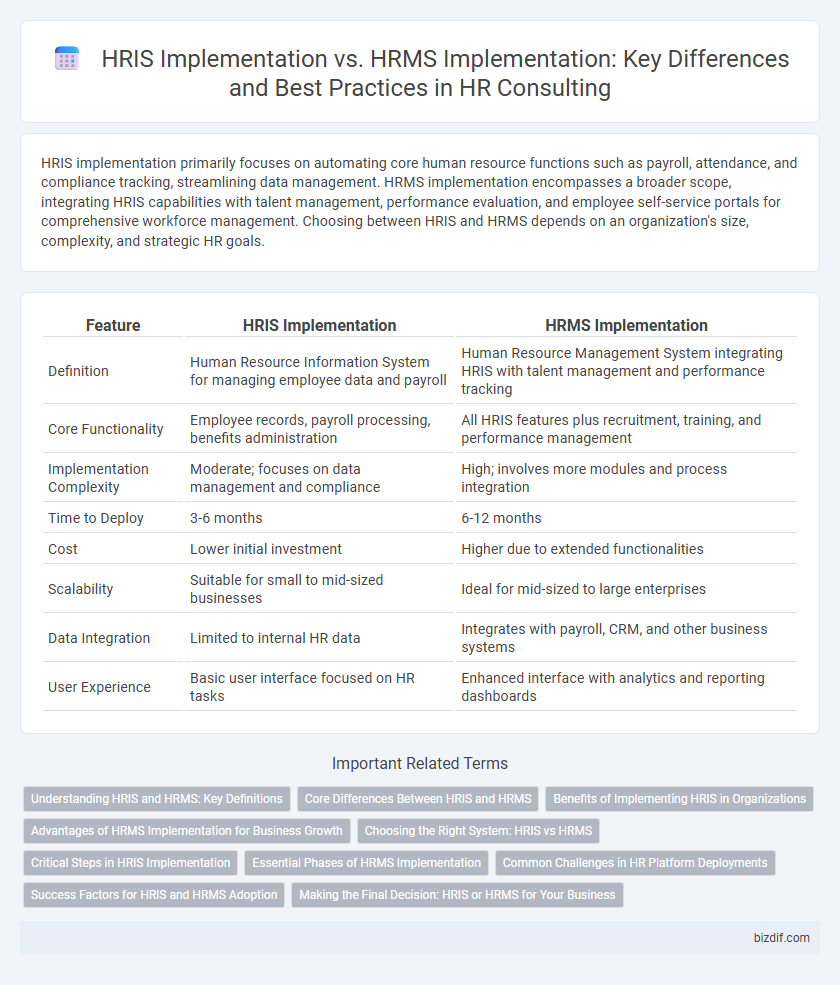HRIS implementation primarily focuses on automating core human resource functions such as payroll, attendance, and compliance tracking, streamlining data management. HRMS implementation encompasses a broader scope, integrating HRIS capabilities with talent management, performance evaluation, and employee self-service portals for comprehensive workforce management. Choosing between HRIS and HRMS depends on an organization's size, complexity, and strategic HR goals.
Table of Comparison
| Feature | HRIS Implementation | HRMS Implementation |
|---|---|---|
| Definition | Human Resource Information System for managing employee data and payroll | Human Resource Management System integrating HRIS with talent management and performance tracking |
| Core Functionality | Employee records, payroll processing, benefits administration | All HRIS features plus recruitment, training, and performance management |
| Implementation Complexity | Moderate; focuses on data management and compliance | High; involves more modules and process integration |
| Time to Deploy | 3-6 months | 6-12 months |
| Cost | Lower initial investment | Higher due to extended functionalities |
| Scalability | Suitable for small to mid-sized businesses | Ideal for mid-sized to large enterprises |
| Data Integration | Limited to internal HR data | Integrates with payroll, CRM, and other business systems |
| User Experience | Basic user interface focused on HR tasks | Enhanced interface with analytics and reporting dashboards |
Understanding HRIS and HRMS: Key Definitions
HRIS (Human Resource Information System) primarily focuses on storing and managing employee data, payroll, and compliance information, serving as a centralized database for HR operations. HRMS (Human Resource Management System) extends beyond HRIS functionalities by integrating talent management, performance evaluation, recruitment, and employee self-service tools into a comprehensive platform. Understanding these core definitions helps organizations select the appropriate system based on operational needs and strategic HR goals.
Core Differences Between HRIS and HRMS
HRIS (Human Resource Information System) primarily focuses on storing employee data and managing payroll, benefits, and compliance, serving as a centralized database for HR-related information. In contrast, HRMS (Human Resource Management System) offers a broader range of functions, integrating HRIS capabilities with talent management, performance tracking, recruitment, and learning management tools. The core difference lies in HRIS handling fundamental HR data and administrative tasks, while HRMS provides a comprehensive platform for strategic HR processes and workforce optimization.
Benefits of Implementing HRIS in Organizations
Implementing an HRIS (Human Resource Information System) streamlines employee data management, enhancing accuracy and accessibility across all HR functions. Organizations benefit from automated payroll processing, leave management, and real-time reporting, leading to improved decision-making and operational efficiency. By centralizing workforce information, HRIS supports regulatory compliance and reduces administrative costs, driving overall productivity growth.
Advantages of HRMS Implementation for Business Growth
HRMS implementation integrates core HR functions such as payroll, recruitment, and performance management into a unified platform, enhancing data accuracy and operational efficiency. This comprehensive approach streamlines workflows, reduces administrative costs, and enables real-time analytics for strategic decision-making. As a result, businesses experience accelerated growth through improved employee productivity and informed talent management.
Choosing the Right System: HRIS vs HRMS
Choosing the right system between HRIS (Human Resource Information System) and HRMS (Human Resource Management System) depends on organizational needs for data management and comprehensive HR functions. HRIS primarily focuses on employee data storage, payroll, and compliance tracking, while HRMS integrates these features with talent management, performance evaluation, and recruitment processes. Evaluating scalability, user interface, and integration capabilities helps businesses optimize HR workflows and align technology with strategic goals.
Critical Steps in HRIS Implementation
Effective HRIS implementation hinges on meticulous planning, including conducting a thorough needs analysis and selecting a scalable, user-friendly system that aligns with organizational goals. Critical steps encompass data migration, system configuration, comprehensive employee training, and robust change management strategies to ensure seamless adoption. Continuous monitoring and iterative optimization post-implementation are essential to maximize HRIS functionality and drive improved workforce management.
Essential Phases of HRMS Implementation
HRMS implementation involves critical phases such as needs assessment, system selection, data migration, and user training focused on integrating human resource information systems for streamlined operations. In contrast to HRIS, HRMS phases emphasize comprehensive functionality, including payroll, recruitment, performance management, and compliance tracking. Properly executed HRMS implementation ensures improved data accuracy, enhanced employee self-service, and scalable human capital management solutions.
Common Challenges in HR Platform Deployments
HRIS implementation and HRMS deployment often face common challenges such as data migration complexities, system integration issues, and user adoption resistance. Ensuring seamless integration with existing payroll and recruitment systems is critical to avoid operational disruptions. Effective change management, comprehensive training programs, and clear communication strategies are essential to overcome these obstacles and maximize platform performance.
Success Factors for HRIS and HRMS Adoption
Successful HRIS and HRMS implementation relies on clear alignment with organizational goals, user-friendly interfaces, and robust data security measures. Employee training, continuous support, and stakeholder engagement drive higher adoption rates and reduce resistance to change. Integrating scalable technology that adapts to evolving HR processes ensures long-term value and operational efficiency.
Making the Final Decision: HRIS or HRMS for Your Business
Choosing between HRIS and HRMS implementation hinges on your business's scope and specific HR needs; HRIS focuses primarily on core HR functions like payroll and attendance, while HRMS offers a comprehensive suite including talent management and performance analytics. Cost considerations, scalability potential, and integration capabilities with existing systems are critical factors in making the final decision. A thorough needs assessment aligned with long-term strategic goals ensures selecting the optimal solution that maximizes operational efficiency and employee experience.
HRIS Implementation vs HRMS Implementation Infographic

 bizdif.com
bizdif.com